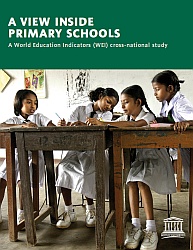 A new publication by the UNESCO Institute for Statistics, A view inside primary schools: A World Education Indicators (WEI) cross-national study, presents new data on quality and equality in primary education. The data is from 11 countries in Asia, Latin America, and North Africa that participated in the Survey of Primary Schools by the World Education Indicators Programme in 2005 and 2006. For the survey, fourth grade teachers and principals from over 7,600 schools responded to questions about teaching and learning conditions.
A new publication by the UNESCO Institute for Statistics, A view inside primary schools: A World Education Indicators (WEI) cross-national study, presents new data on quality and equality in primary education. The data is from 11 countries in Asia, Latin America, and North Africa that participated in the Survey of Primary Schools by the World Education Indicators Programme in 2005 and 2006. For the survey, fourth grade teachers and principals from over 7,600 schools responded to questions about teaching and learning conditions.The countries in the study - Argentina, Brazil, Chile, India, Malaysia, Paraguay, Peru, Philippines, Sri Lanka, Tunisia, and Uruguay - are close to the Millennium Development Goal of universal primary education. However, the survey reveals large resource gaps between schools in urban and rural areas. Children in poorly equipped and maintained schools often come from poor families and these children are thus doubly disadvantaged.
Other findings of the survey include:
- In Paraguay, the Philippines, and Sri Lanka, more than one in five pupils attended schools without running water.
- In India, Paraguay, Peru, the Philippines, Sri Lanka, and Tunisia, less than half of all pupils were in schools with a telephone.
- Sri Lanka was the only country participating in the survey that provided free textbooks to virtually all pupils.
- The overall weekly teaching load for Grade 4 teachers working in only one school ranged from 14 hours in Malaysia to 31 hours in Chile and the Philippines. The average teaching load was 23 hours per week.
- In all countries in the survey - except in India, Malaysia, and Sri Lanka - most teachers expressed low levels of satisfaction with their salaries.
External links
- Download A view inside primary schools (PDF document, 2.9 MB)
- Press release by the UNESCO Institute for Statistics
- UN Millennium Development Goals
- UNESCO releases data from 2007 education survey
- Pupil/teacher ratio in primary school
- EFA Global Monitoring Report 2008
- Global Education Digest 2007
Permanent URL: http://huebler.blogspot.com/2008/07/primary-schools.html







